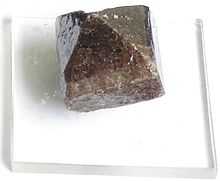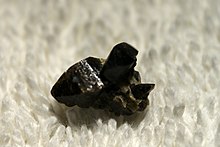User:Fhernly/MineralExample
| Zircon | |
|---|---|
 | |
| General | |
| Category | Mineral |
| Formula (repeating unit) | zirconium silicate ZrSiO4 |
| Crystal system | Tetragonal Ditetragonal Dipyramidal 4/m 2/m 2/m |
| Space group | Tetragonal 4/m 2/m 2/m |
| Unit cell | a = 6.607(1) Å, c = 5.982(1) Å; Z=4 |
| Identification | |
| Color | Reddish brown, yellow, green, blue, gray, colorless; in thin section, colorless to pale brown |
| Crystal habit | tabular to prismatic crystals, irregular grains, massive |
| Twinning | On {101} |
| Other characteristics | Fluorescent and radioactive, may form pleochroic halos |
| References | [1][2][3][4] |
This is an example of the formatting and information to be utilized in your mineral article. This top area should include a summary of the mineral providing general information such as the color(s) and mineral class; chemical composition as a formula; when, where, and by whom it was discovered; the orgin of the name, if known; and any other relavent information that is too brief to warrent a whole section.
Zircon (pronounced /ˈzɜrkən/; is a mineral belonging to the nesosilicates group. Its chemical name is zirconium silicate and its corresponding chemical formula is ZrSiO4. A common empirical formula showing some of the range of substitution in zircon is (Zr1–y, REEy)(SiO4)1–x(OH)4x–y. Zircon forms in silicate melts with concentrated incompatible elements and accepts high field strength elements into its structure. For example, hafnium is almost always present in quantities ranging from 1 to 4%. The crystal structure of zircon is tetragonal crystal system. The natural color of zircon varies between colorless, yellow-golden, red, brown, blue, and green. Colorless specimens that show gem quality are a popular substitute for diamond; these specimens are also known as "Matura diamond".
The box below will be automatically created when your section headings are formatted with two equal signs before and after the heading like this ==Heading==.
Origin of the Name
[edit]I created the "origin of the name" heading since the explaination for zircon's name was located in the introduction about, but was quite lengthy; your mineral will probably not need this. Do note in this section how refereces are handled by looking at the "edit this page" tab. You will essentially add the reference information between two <ref> codes. For example, in the block of text below the citation for "zargono" which shows up as only a number 5 in brackets is created by adding the text below:
<ref>{{cite web| last = Pearse| first = Roger| title = Syriac Literature| date = 2002-09-16| url = http://www.tertullian.org/rpearse/oriental/syriac.htm| accessdate = 2008-02-11}}</ref>
Scroll down to see how the reference then is displayed in the reference section
The name either derives from the Syriac word ܙܐܪܓܥܢܐ zargono,[5] from the Arabic word zarqun (زرقون), meaning vermilion, or from the Persian zargun (زرگون), meaning golden-colored.[6] These words are corrupted into "jargoon", a term applied to light-colored zircons. The English word "Zircon" is derived from "Zirkon," which is the German adaptation of these words.[7] Yellow zircon is called "hyacinth", from the flower hyacinthus, whose name is of Ancient Greek origin; in the Middle Ages all yellow stones of East Indian origin were called hyacinth, but today this term is restricted to the yellow zircons.
Properties
[edit]
This section is fairly self explainatory. While this may seem like a rehash of the properties in the infobox, you have the opportunity to add additional information that is not included in the info box (For example the size of the crystals as mentioned below for zircon).
Zircon is a remarkable mineral,[citation needed] if only for its almost ubiquitous presence in the crust of Earth. It occurs in igneous rocks (as primary crystallization products), in metamorphic rocks and in sedimentary rocks (as detrital grains). Large zircon crystals are seldom abundant. Their average size, e.g. in granite rocks, is about 0.1–0.3 mm, but they can also grow to sizes of several centimeters (a few inches), especially in pegmatites.
Owing to their uranium and thorium content, some zircons may undergo metamictization. The processes, related to internal radiation damage, partially disrupt the crystal structure and partly explain the highly-variable properties of zircon. As zircon becomes more and more modified by internal radiation damage, the density decreases, the crystal structure is compromised, and the color changes. Zircon is a common accessory mineral that occurs worldwide. Noted occurrences include: Australia; Barbados;Russia (Ural Mountains); Trentino, Monte Somma, and Vesuvius, Italy; Arendal, Norway; Sri Lanka; India; Indonesia, Java, Kalimantan, Sulawesi; Thailand; Ratanakiri, Cambodia; the Kimberley mines, Republic of South Africa; Madagascar; Renfrew County, Ontario, and Grenville, Quebec, Canada; and Litchfield, Maine; Chesterfield, Massachusetts; Essex, Orange, and St. Lawrence counties, New York; Henderson County, North Carolina; the Pikes Peak district of Colorado; and Llano County, Texas in the United States. Australia leads the world in zircon mining, producing 37% of the world total and accounting for 40% of world EDR (economic demonstrated resources) for the mineral. Thorite (ThSiO4) is an isostructural related mineral. Barbados produces 12% of the world total and 17% of world EDR accordingly.
Zircon occurs in many colors, including red, pink, brown, yellow, hazel, black, or colorless. The color of zircons sometimes can be changed by heat treatment. Depending on the amount of heat applied, colorless, blue, and golden-yellow zircons can be made. In geological settings, the development of pink, red, and purple zircon occurs after hundreds of millions of years provided the crystal has sufficient trace elements to produce color centers. Color in this red or pink series is annealed in geological conditions above the temperature about 350 °C.
Applications
[edit]
Zircon is mainly consumed as a opacifier in the decorative ceramics industry.[8] It is also the principal precursor to metallic zirconium, although this application is small, and all compounds of zirconium including zirconium oxide (ZrO2), one of the most refractory materials known.
Occurrence
[edit]
This area should be used for two aspects of the minerals occurrence: General occurrence with respect to the rocks cycle (is it a metamorphic mineral formed in hight temperature contact zones) and the specific geographic localitites where the mineral is found (mountains of northern Russia, the Mines of Moria, or where ever). Zircon is a common accessory mineral of most granite and other felsic igneous rocks. Due to its hardness, durability and chemical inertness, zircon persists in sedimentary deposits and is a common constituent of most sands. Zircon is rare within mafic rocks and very rare within ultramafic rocks aside from a group of ultrapotassic intrusive rocks such as kimberlites, carbonatites, and lamprophyre, where zircon can occasionally be found as a trace mineral owing to the unusual magma genesis of these rocks.
Zircon forms economic concentrations within heavy mineral sands ore deposits, within certain pegmatites, and within some rare alkaline volcanic rocks, for example the Toongi Trachyte, Dubbo, New South Wales Australia[9] in association with the zirconium-hafnium minerals eudialyte and armstrongite.
Uses
[edit]Use this this area to provide information about the uses, if any, of the mineral. For instance, is the mineral used as an ore or in industry, as a gemstone, or some other use. Zircons from Jack Hills in the Narryer Gneiss Terrane, Yilgarn Craton, Western Australia, have yielded U-Pb ages up to 4.404 billion years,[10] interpreted to be the age of crystallization, making them the oldest minerals so far dated on Earth. In addition, the oxygen isotopic compositions of some of these zircons have been interpreted to indicate that more than 4.4 billion years ago there was already water on the surface of the Earth.[10][11] This interpretation is supported by additional trace element data,[12][13] but is also the subject of debate.[14][15]
Gallery
[edit]The gallery is used to provide a space for additional images that may exist for the mineral that are NOT used within the main body of the article. If included, these should be significantly different from others in the article.
-
Crystal structure of zircon
-
A unit cell
-
Zircon collection at the National Museum of Natural History
-
Polished surface of the oldest zircon so far found on Earth[10]
-
SEM image of zircon
-
A small sample of zircon.
Similar minerals
[edit]Hafnon (HfSiO4), Xenotime (YPO4), Béhierite, Schiavinatoite ((Ta, Nb)BO4), Thorite, (ThSiO4), and Coffinite (USiO4) all share the same crystal structure (VIIIX IVY O4) as Zircon.
See also
[edit]References
[edit]- ^ Handbook of Mineralogy
- ^ Mindat
- ^ Webmineral
- ^ Hurlbut, Cornelius S.; Klein, Cornelis, 1985, Manual of Mineralogy, 20th ed., ISBN 0-471-80580-7
- ^ Pearse, Roger (2002-09-16). "Syriac Literature". Retrieved 2008-02-11.
- ^ Stwertka, Albert (1996). A Guide to the Elements. Oxford University Press. pp. 117–119. ISBN 0-19-508083-1.
- ^ http://www.etymonline.com/index.php?term=zircon
- ^ Ralph Nielsen "Zirconium and Zirconium Compounds" in Ullmann's Encyclopedia of Industrial Chemistry, 2005, Wiley-VCH, Weinheim. doi:10.1002/14356007.a28_543
- ^ "Dubbo Zirconia Project Fact Sheet June 2007" (PDF). 06/2007. Retrieved 2007-09-10.
{{cite web}}:|first=missing|last=(help); Check date values in:|date=(help) - ^ a b c Wilde S.A., Valley J.W., Peck W.H. and Graham C.M. (2001). "Evidence from detrital zircons for the existence of continental crust and oceans on the Earth 4.4 Gyr ago" (PDF). Nature. 409 (6817): 175–178. doi:10.1038/35051550. PMID 11196637. S2CID 4319774.
{{cite journal}}: CS1 maint: multiple names: authors list (link) - ^ Mojzsis, S.J., Harrison, T.M., Pidgeon, R.T. (2001). "Oxygen-isotope evidence from ancient zircons for liquid water at the Earth's surface 4300 Myr ago". Nature. 409 (6817): 178–181. doi:10.1038/35051557. PMID 11196638. S2CID 2819082.
{{cite journal}}: CS1 maint: multiple names: authors list (link) - ^ Ushikubo, T., Kita, N.T., Cavosie, A.J., Wilde, S.A. Rudnick, R.L. and Valley, J.W. (2008). "Lithium in Jack Hills zircons: Evidence for extensive weathering of Earth's earliest crust". Earth and Planetary Science Letters. 272 (3–4): 666–676. Bibcode:2008E&PSL.272..666U. doi:10.1016/j.epsl.2008.05.032.
{{cite journal}}: CS1 maint: multiple names: authors list (link) - ^ "Ancient mineral shows early Earth climate tough on continents". Physorg.com. June 13, 2008.
- ^ Nemchin, A.A., Pidgeon, R.T., Whitehouse, M.J. (2006). "Re-evaluation of the origin and evolution of >4.2 Ga zircons from the Jack Hills metasedimentary rocks". Earth and Planetary Science Letters. 244 (1–2): 218–233. Bibcode:2006E&PSL.244..218N. doi:10.1016/j.epsl.2006.01.054.
{{cite journal}}: CS1 maint: multiple names: authors list (link) - ^ Cavosie, A.J., Valley, J.W., Wilde, S.A., E.I.M.F. (2005). "Magmatic δ18O in 4400–3900 Ma detrital zircons: a record of the alteration and recycling of crust in the Early Archean". Earth and Planetary Science Letters. 235 (3–4): 663–681. Bibcode:2005E&PSL.235..663C. doi:10.1016/j.epsl.2005.04.028.
{{cite journal}}: CS1 maint: multiple names: authors list (link)
External links
[edit]Further reading
[edit]
|
|
Category:Zirconium minerals Category:Nesosilicates Category:Refractory materials Category:Gemstones Category:Arabic words and phrases Category:Tetragonal minerals





